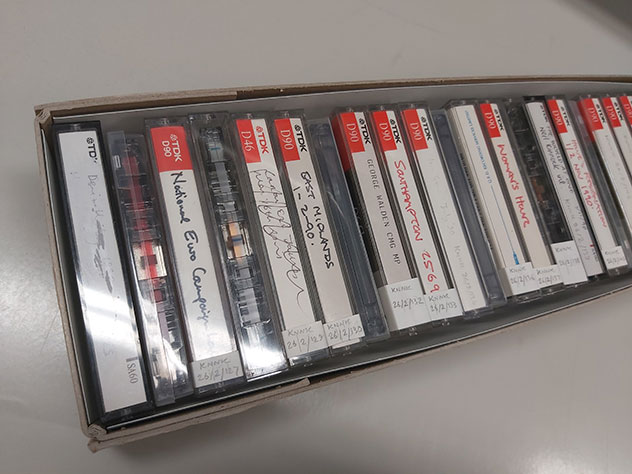The British Library’s Save our Sounds project undertook a national audit to map the condition of sound archives around the country and create a comprehensive picture of the nation’s sound collections with the creation of a UK Sound Directory.
In 2015 we completed the BL survey form and were added to the UK Sound Directory.
This audit gathered information on over 1.8 million recordings held in over 3,000 collections much of it under imminent threat from loss and decay.
The challenge of preserving these sounds is the focus of the BL’s Unlocking Our Sound Heritage project which is being funded by the HLF.
The BL have ten hub partners for this, and Norfolk Record Office is one of these. In March 2019, after much deliberation by them and us about which collections to digitise, we carefully packed up 402 sound carriers from 15 collections and they were taken to Norfolk RO by the excellent team recently recruited to carry out the task. Overall, this amounted to more than 350 hours of content.

Some of the cassette tapes from the Kinnock collection which were sent for copying.
The original audio carriers and the digital copies were returned to us in February this year and the Archives Centre is now in the process of updating the catalogues. This is one of the projects that we have been able to do effectively while working from home, now that we have easy digital access to the material.
Our thanks go to the British Library and the Norfolk Record Office for making this possible.
How was the material chosen?
We have thousands of audio tapes (as well as records) so it was not possible to include them all unfortunately.
To be included, the material had to be in an analogue (or early digital) format and the recordings had to be unique or rare. Recordings had to have historical importance as far as could be determined and copyright and ethics were also a consideration. Finally, it had to be a collection which had not already been fully digitised to preservation standards.
So, for example, the Rotblat collection contains numerous mainly open reel tapes and we were told that these had been picked up by the BL for mention in the project application as they had high potential research value.
What are the benefits of the project?
There are two main benefits that will come from our participation in this project; preservation and access.
These materials were previously held on a number of different formats. By today’s standards some are relatively simple, such as audio cassettes, but some more unusual; the items sent to the NRO included 281 compact cassettes, 47 microcassettes, 73 open tape reels and 1 CD.

Studer machine used at NRO for copying open reel audio tapes (image from NRO UOSH East of England Hub).

The audio copying set-up at NRO (image from NRO UOSH East of England Hub).
While we are able to play (for copying purposes) audio cassettes due to the hardware in the College’s AudioVisual Department, the same is not true for the microcassettes or tape reels, which sit in our collections but could not be copied for a reader on demand. Additionally, the handling involved in playback, even if we had the equipment, would potentially damage the items on each use. We don’t currently have the time or resources to deal with this quantity of audio material and as time passes, more degradation of the magnetic tape will occur. The instability of magnetic tape is mainly due to the plastic base (cellulose acetate in some cases) and the binder layer which can become ‘sticky’. With all the material now digitised, we can relatively easily provide it on-site to the users of our Reading Room, as part of remote enquiries, and potentially in future digital outreach projects – watch this space!
Sarah Lewery, Conservator
Subscribe to Churchill Archives Centre News
Subscribe to the Churchill Archives News RSS feed:
